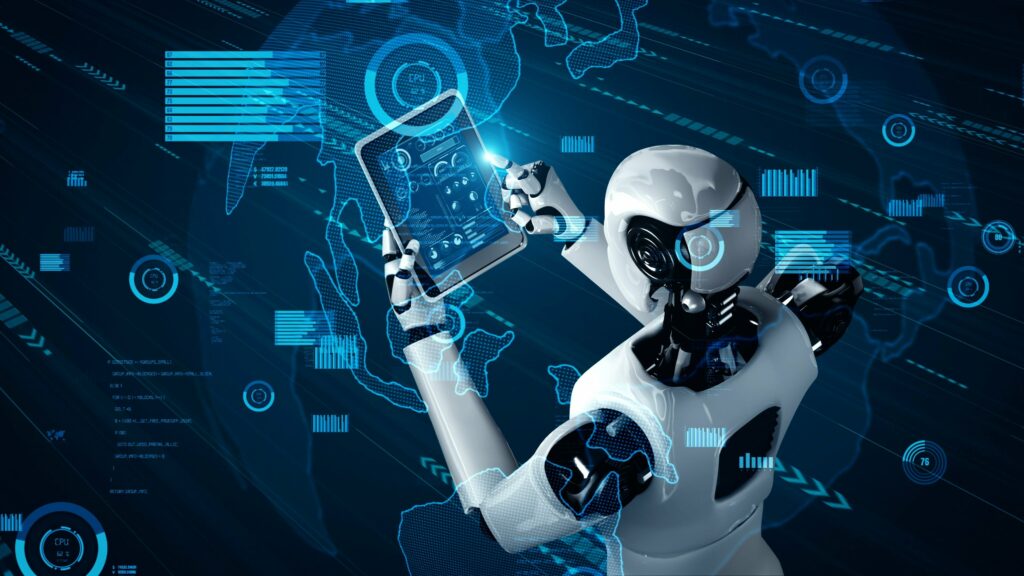The world of finance is undergoing a digital revolution, and at the forefront of this change are AI trading bots. These automated programs, powered by artificial intelligence (AI), are transforming the way traders interact with the market. But what exactly are AI trading bots, and how do they work? This blog post delves into the fascinating world of AI trading bots, exploring their capabilities, benefits, potential drawbacks, and the future of this innovative technology.
Understanding AI Trading Bots
An AI trading bot is a software program that uses algorithms and machine learning to analyze market data and execute trades autonomously. These bots can be programmed to follow various trading strategies based on technical indicators, fundamental analysis, or a combination of both. Here’s a breakdown of the key components:
- Market Data Analysis: AI trading bots ingest massive amounts of market data, including historical price charts, order book depth, news feeds, and social media sentiment.
- Algorithmic Trading Strategies: The core of the bot lies in its pre-defined trading strategy. This strategy could be based on technical analysis indicators like moving averages or relative strength index (RSI), or it could leverage machine learning models to identify patterns and trends in the market.
- Automated Trade Execution: Once the bot identifies a trading opportunity based on its programmed strategy, it can automatically execute trades without human intervention. This allows for faster and more precise execution, especially in volatile markets.
Benefits of AI Trading Bots
There are several advantages to using AI trading bots in the financial markets:
- Reduced Emotional Trading: Human emotions can often cloud judgment, leading to impulsive decisions and costly mistakes. AI ki trading bot , devoid of emotions, execute trades based on predefined logic, minimizing emotional bias.
- 24/7 Market Monitoring: Traditional traders are limited by time constraints. AI bots, however, can continuously monitor the market for trading opportunities, even during off-market hours. This allows for capturing opportunities that might be missed otherwise.
- Backtesting and Optimization: AI trading bots can be backtested on historical data to assess their performance under various market conditions. This allows for continuous improvement and optimization of trading strategies.
- Faster Execution: In fast-moving markets, milliseconds can make a significant difference. AI bots can execute trades at lightning speed, taking advantage of fleeting market opportunities.
- Increased Discipline: By following a pre-defined trading strategy, AI bots can enforce discipline on traders who might otherwise deviate from their plan due to emotional impulses.
Potential Drawbacks of AI Training Bots
While AI trading bots offer numerous benefits, it’s crucial to acknowledge their limitations:
- Black Box Problem: The complex algorithms behind some AI bots can be opaque, making it difficult to understand how they arrive at trading decisions. This lack of transparency can be unsettling for some traders.
- Market Volatility: AI bots are trained on historical data. However, markets are inherently unpredictable, and unforeseen events can disrupt even the most sophisticated algorithms.
- Technical Reliance: AI bots rely heavily on technology. System outages or software glitches can lead to missed opportunities or erroneous trades.
- Regulatory Uncertainty: The regulatory landscape surrounding AI trading bots is still evolving. As these technologies become more prevalent, regulations may need to adapt to ensure fair and transparent markets.
The Future of AI Trading Bots
AI trading bots are still in their early stages of development, but their potential is undeniable. As AI algorithms become more sophisticated and access to real-time data expands, we can expect to see AI bots playing an increasingly prominent role in financial markets. However, it’s important to remember that AI bots are tools, not a magic bullet.
Here are some key trends to watch in the future of AI trading bots:
- Increased Customization: AI bots will become more customizable, allowing traders to tailor their strategies to their specific risk tolerance and investment goals.
- Integration with Human Expertise: A hybrid approach, combining the analytical power of AI bots with the experience and intuition of human traders, may become the norm.
- Focus on Risk Management: As AI bots become more prevalent, managing risk will become paramount. Advanced algorithms will be developed to identify and mitigate potential losses.
- Regulation and Transparency: Regulatory bodies will likely introduce new frameworks to ensure responsible development and use of AI trading bots.
Conclusion
The rise of AI trading bots is undoubtedly changing the face of finance. While they offer significant advantages, it’s crucial to understand their limitations and use them in conjunction with sound risk management practices. Ultimately, the future of trading lies in a collaborative approach, where humans leverage the power of AI to make informed trading decisions.



